标签:答案 space private content 取出 cas 操作 quit 自己

bank.h
#include <string> using namespace std; class BankAccount { private: std::string m_name;//若是不用命名空间的话,就需要加std:: string m_id; double m_money; public: BankAccount(); BankAccount(const string & name,const string & id,double money=0.0); void show() const; void add(double money); void sub(double money); };
bank.cpp
#include <iostream> #include "bank.h" //构造函数 BankAccount::BankAccount(){ m_name = ""; m_id = ""; m_money = 0.0; } BankAccount::BankAccount(const string & name,const string & id,double money){ m_name = name; m_id = id; m_money = money; } void BankAccount::show() const{ ios_base::fmtflags orig=cout.setf(ios_base::fixed,ios_base::floatfield);//设置cout对象的一个标记,命令cout使用定点表示法 streamsize prec=cout.precision(2); cout<< "Name: " << m_name << " ID: " << m_id << " Money: " << m_money << endl; //因为bank.h中已经声明了命名空间,所以不需要加std:: } void BankAccount::add(double money){ m_money += money; } void BankAccount::sub(double money){ m_money -= money; }
main.cpp
#include "bank.h" void main(){ BankAccount a("MR.Zhang","20135908",8888888.88); a.show(); a.add(88888.88); a.show(); a.sub(88888.88); a.show(); system("pause"); }

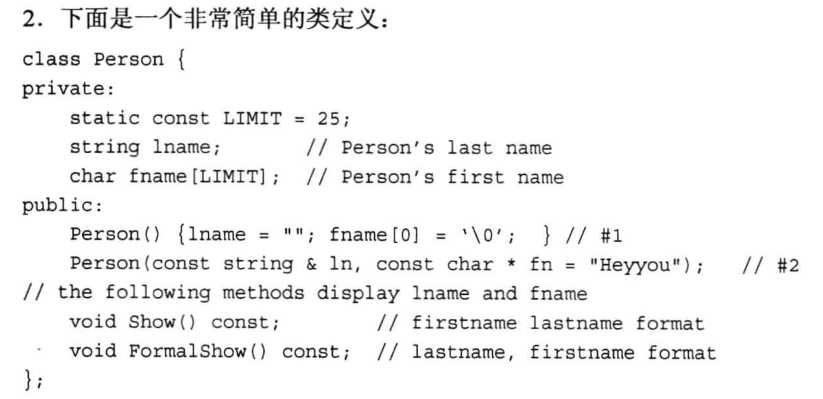

//person.h #include <string> class Person { private: static const int LIMIT = 25; std::string lname; char fname[LIMIT]; public: Person() { lname = ""; fname[0] = ‘\0‘; } //无参数 Person(const std::string &ln, const char *fn = "Heyyou"); //两参数 void Show() const; void FormalShow() const; }; //person.cpp #include <iostream> #include "Person.h" Person::Person(const std::string & ln, const char *fn) { lname = ln; strncpy_s(fname, fn ,24); //fname的长度为25 } void Person::Show() const { std::cout << fname << " " << lname << std::endl; } void Person::FormalShow() const { std::cout << lname << ", " << fname << std::endl; } //main.cpp #include "person.h" void main(){ Person one; Person two("Smythecraft"); Person three("Dimwiddy", "Sam"); one.Show(); one.FormalShow(); two.Show(); two.FormalShow(); three.Show(); three.FormalShow(); system("pause"); }
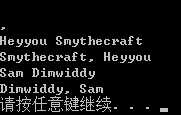
前两行的显示:one为空,没有输出,FormalShow有一个逗号
3.完成第9章的编程练习1,但要用正确的golf类声明替换那里的代码。用带合适参数的构造函数替换setgolf ( golf &, const char*, int), 以提供初始值。保留setgolf()的交互版本,但要用构造函数来实现它(例如,setgolf()的代码应该获得数据,将数据传递给构造函数来创建一个临时对象,并将其赋给调用对象,即*this)。
4.完成第9章的编程练习4,但将Sales结构及相关的函数转换为一个类及其方法。用构造函数替换setSales ( sales&, double [] , int)函数。用构造函数实现setSales(Sales&)方法的交互版本。将类保留在名称空间SALES中。
这两题参考http://blog.csdn.net/qq20004604/article/details/50540039 或者 http://blog.csdn.net/acm_yuuji/article/details/47374799
5.考虑下面的结构声明:
struct customer {
char fullname[35];
double payment;
};
编写一个程序,它从栈中添加和删除cunstomer结构(栈用Stack类声明表示)。每次customer结构被删除时,其payment的值都将被加入到总数中,并报告总数。注意:应该可以直接使用Stack类而不做修改;只需修改typedef声明,使Item的类型为customer,而不是unsigned long即可。
//stack.h struct customer{ char fullname[35]; double payment; }; typedef customer Item; class Stack //类声明 { private: double total; enum{MAX=10}; Item items[MAX]; int top; public: Stack(); //默认构造函数 bool isempty() const; bool isfull() const; bool push(const Item & item);//压栈 bool pop(Item & item);//出栈 }; //stack.cpp #include <iostream> #include "stack.h" //构造函数 Stack::Stack(){ top=0; total=0; } bool Stack::isempty() const{ return top==0;//top为0返回true,反之为false } bool Stack::isfull() const{ return top==MAX; } bool Stack::push(const Item &item){ if(top<MAX){ items[top++]=item; return true; }else return false; } bool Stack::pop(Item &item){ if(top>0){ item=items[--top]; total += item.payment; std::cout << "总共已取出" << total << "元" << std::endl; return true; }else return false; } //main.cpp #include<iostream> #include<cctype> #include "stack.h" using namespace std; void main(){ cout.setf(ios_base::fixed); cout.precision(2); //设置输出保留两位小数 Stack st;//创建对象储物柜 customer one; char ch; cout<<"Enter A to save money, P to withdraw money, Q to quit.\n"; while (cin>>ch&&toupper(ch)!=‘Q‘) { while(cin.get()!=‘\n‘)//如果不是换行就继续 continue; if (!isalpha(ch))//如果不是字母就继续 { cout<<‘\a‘; continue; } switch (ch) { case ‘A‘: case ‘a‘: if(st.isfull())//该方法判断:如果满了(top等于MAX)返回true,没满返回false cout<<"Stack already full\n"; else{ cout << "请输入存钱的人的名字:"; cin.getline(one.fullname,34); cout << "请输入要存多少钱:"; cin >> one.payment; cin.sync(); //清除输入缓存,防止干扰 if (st.push(one)) cout << "存放成功!" << one.fullname << " 共计 " << one.payment << " 元钱已经被存进来啦!" << endl; else cout << "由于某种未知的原因,存放失败了。。。。" << endl; } break; case ‘P‘: case ‘p‘: if(st.isempty()) cout<<"Stack already empty\n"; else{ st.pop(one); } break; } cout<<"Enter A to save money, P to withdraw money, Q to quit.\n"; } system("pause"); }
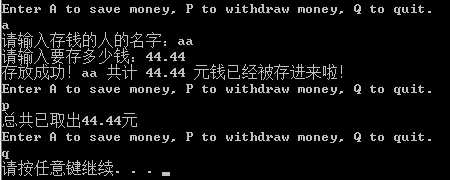
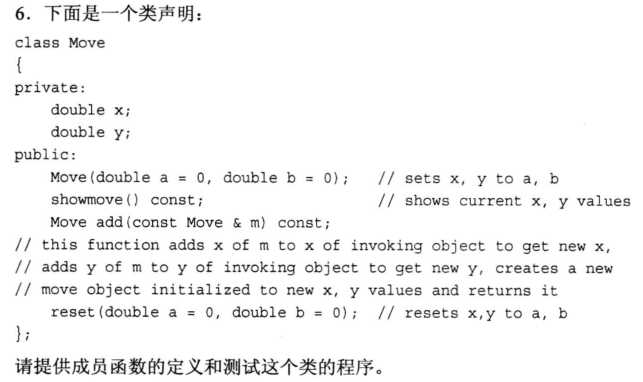
//1.h class Move { private: double x; double y; public: Move(double a = 0, double b = 0); //set x,y to a,b void showmove()const; //shows current x,y values Move add(const Move & m) const; //这个函数将被调用对象m的x和y值与自己的x,y值相加,并得到2个新值,然后创建一个使用新的x、y值的move对象,并将增加后的x、y值赋给她,然后将这个新对象作为返回值 void reset(double a = 0, double b = 0); //resets x,y to a,b }; //1.cpp #include <iostream> #include "1.h" Move::Move(double a, double b){ x = a; y = b; } void Move::showmove()const{ std::cout << "x = " << x << ", y = " << y << std::endl; } Move Move::add(const Move & m) const{ Move q(this->x + m.x, this->y + m.y); return q; } void Move::reset(double a , double b ){ x = a; y = b; } //main.cpp #include<iostream> #include "1.h" void main(){ Move m,n(1.5,2.5); m.showmove(); m=m.add(n); m.showmove(); m.reset(); m.showmove(); system("pause"); }

7.Betelgeusean plorg有这些特征。
数据:
①plorg的名称不超过19个字符;
②plorg有满意指数(CI),这是一个整数。
操作:
①新的plorg将有名称,其CI值为50;
②plorg的CI可以修改;
③plorg可以报告其名称和CI;
④plorg的默认名称为“Plorga”。
请编写一个Plorg类声明(包括数据成员和成员函数原型)来表示plorg,并编写成员函数的函数定义。然后编写一个小程序,以演示Plorg类的所有特性。
//1.h class Plorg { private: char m_name[20]; int m_CI; public: Plorg(char * name = "Plorga", int CI = 50); void show()const; void setName(const char *name); void setCI(const int CI); }; //1.cpp #include <iostream> #include "1.h" Plorg::Plorg(char * name, int CI){ strncpy_s(m_name, name,19); m_CI = CI; } void Plorg::setName(const char *name){ strncpy_s(m_name, name,19); } void Plorg::setCI(const int CI){ m_CI = CI; } void Plorg::show()const{ std::cout << "name = " << m_name << ", CI = " << m_CI << std::endl; } //main.cpp #include<iostream> #include "1.h" void main(){ Plorg p; p.show(); p.setName("Jany"); p.setCI(49); p.show(); system("pause"); }

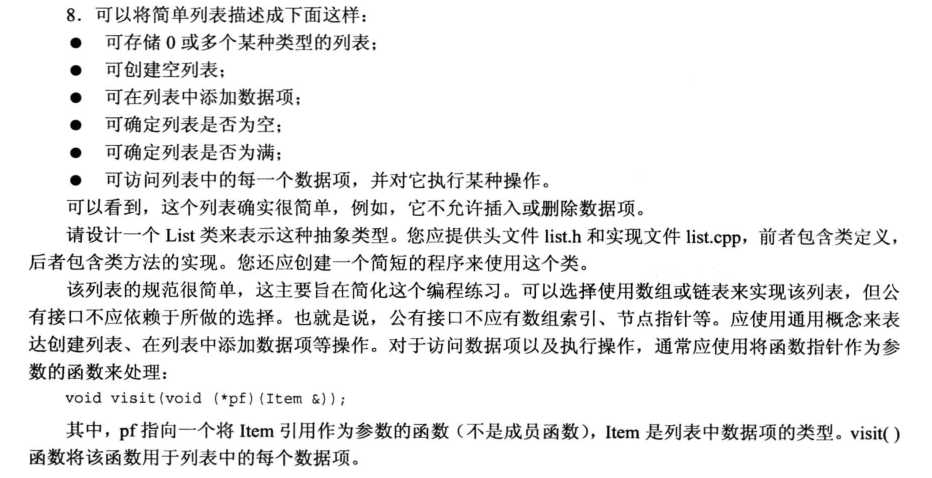
//list.h #include <stdlib.h> //包含NULL的定义 typedef int Item; class List { private: static const int LIMIT = 5; Item items[LIMIT]; int top; public: List() { top = 0; } //默认构造函数 bool push(const Item); //添加数据项 bool isempty()const; //确定是否为空 bool isfull()const; //是否为满 void visit(void(*pf)(Item &m)); //显示每个数据项,并执行某种操作,具体是哪种,根据指针指向的函数而定 }; //list.cpp #include "List.h" bool List::push(const Item item) { if (isfull() == true) return false; items[top++] = item; return true; } bool List::isempty() const { return top == 0 ? true : false; } bool List::isfull() const { return top == LIMIT ? true : false; } void List::visit(void(*pf)(Item &item)) { for (int i = 0; i < top; ++i) (*pf)(items[i]); } //main.cpp #include<iostream> #include "list.h" void Print(Item &item) { std::cout << item << std::endl; } void main(){ List l; l.push(1); l.push(2); l.push(3); l.push(4); if(l.isempty()) std::cout << "isEmpty? " << "Empty" << std::endl; else std::cout << "isEmpty? " << "Not Empty" << std::endl; if(l.isfull()) std::cout << "isFull? " << "Full" << std::endl; else std::cout << "isFull? " << "Not Full" << std::endl; void(*pf)(Item &item); pf = Print; //或者 void(*pf)(Item &item) = Print l.visit(pf); system("pause"); }
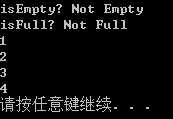
总结:
①在类中以函数指针作为参数的时候,纠结了很久,查了别人的答案才明白。
例如:void visit( void (*pf)(Item& m) );
这个的意思是,visit函数中,使用函数指针pf作为参数。
在调用visit函数时,哪个函数名作为参数放在里面,那么pf指针就指向哪个函数(前提是类型相同)。
因为指针作为参数,所以参数有点类似( char* pa)这样的意思,char*表示pa是char类型的指针,但不是说char*是参数,所以函数指针作为参数时,重点是pf,而不是外面那个修饰pf的。
可以使用typedef void (*PP)(Item &m);将PP作为这个的别名,于是可以改为void visit(PP pf);这样。
因为没把函数指针学透,纠结了很久,写完代码才想明白。
因为pf是函数指针,所以函数内部的pf(items[i])是将items[i]作为参数给pf指向的函数。例如当show函数作为参数给visit时,这里相当于show(items[i])。
版权声明:出处http://blog.csdn.net/qq20004604
[C++ Primer Plus] 第10章、对象和类(二)课后习题
标签:答案 space private content 取出 cas 操作 quit 自己
原文地址:http://www.cnblogs.com/little-monkey/p/7748044.html